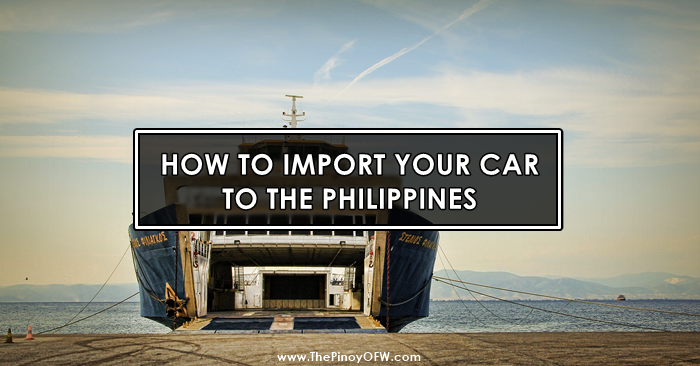One of the status symbols that Filipinos abroad get to invest in are cars. Cars are ultimate symbols that you have made it. For some, the flashier the car, the better. However, as we know, OFWs are bound by contracts and need to come back to their originating countries when their contracts and visa are up. Of course, some of our fellow OFWs do not wish to dispose of their acquired properties justifying it as their investment.
In such cases, cars are among the hardest to let go. Apartment leasing rights are easy to dispose of; appliances can be taken off via garage sales and swap meets. Cars, being huge and costly, are a different matter altogether. So some OFWs would decide to bring their cars to the Philippines at a huge cost.

Guide to Importing Cars from Abroad to the Philippines
So how would should you go with it? Here are the steps and guidelines for importing your car to the Philippines:
- Make sure your car is considered as brand-new. The Bangko Sentral ng Pilipinas issued Circular 92 series of 1995 which liberalized the importation of brand-new vehicles of all types. It simply means any Filipino can opt to import vehicles to the country without the need to ask for authorization to import.
In order for your car to be considered as brand-new, it must satisfy the following conditions:
* Your vehicle is of the current year model or an advanced year model.
* It has never been registered or used;
* It is covered by a certificate of first ownership;
* It has a mileage of not more than 50 kilometers
- If your car does not satisfy the criterion, then do not worry, you can still import it to the country! It will be imported as a used vehicle. However, you need to get authorization from the requisite government agencies to do so. It will be a bit longer to process but you’ll still get to import your automotive pride and joy.
Here are the eligibility parameters for importing used vehicles:
- A Filipino Resident – a citizen who has stayed in a foreign country for one year and whose residency shall be accumulated within the three-year period immediately preceding the date of application filing;
- An immigrant – a person who holds any of the following visa types as per the Philippine Immigration Act of 1940: (a) A Filipino citizen holding a 13G Visa under Section 13, Sub g (13g); (b) A foreign national married to a Filipino and a holder of 13A Visa under Sec.13,Sub a (13a); (c) A Filipino citizen and holder of 47A and 47A2 issued to awardees of Special Government Project/s (SPG).e.g. Philippine Retirement Authority and Balik-Scientist Program.
There are additional considerations for your vehicle to be imported:
- It should weigh not more than three tons gross
- It should be covered by the Certificate of Authority to Import issued under the No-Dollar Importation Program of the Bureau of Importation Services (BIS)
- The vehicle is registered to the importer for at least six months prior to the application date
- It is intended for personal use
- It will not be resold in the next three years
- Make sure you would be personally processing the application to avoid complications.
- Ensure that your vehicle is a left-hand drive. If your vehicle is a right hand drive, you need to convert it to a left-hand drive to satisfy Philippine driving conditions.
- Prepare to shell out the necessary taxes and importation duties. Whether your vehicle is brand-new, used or donated you will have to face the following considerations: 40% Customs duty, 10% VAT and an Ad Valorem Tax that ranges from 15% to 100% depending on the vehicle’s piston displacement. You must also remember that the basis for the computation of these financial considerations is not your acquisition cost but the universally accepted book value of the vehicle. These book values would come from the accepted basis of the originating country (Red Book, Blue Book or World Book).
- Remember that spare parts will also be taxed separately. Inspectors are pretty strict about it so do not try to hide them otherwise you’ll be penalized.
- Prepare to shell out additional fees such as arrastre and storage fees from private arrastre operators. There will also be wharfage duties due to the Philippine Ports Authority (PPA) before you can get a release for your vehicle.
Importers must secure the Prior Import Authority (PIA) from the BIS before sending the vehicle. Otherwise, if the shipment is found out, you would have to pay heavy fines atop the importation taxes and duties.
For further assistance and other valuable information regarding importation fees and possible duties, an importer may inquire via the Bureau of Customs (http://www.dof.gov.ph/index.php/directory/bureau-of-customs/) or the Manila international Container Port terminal (http://www.mictweb.com).